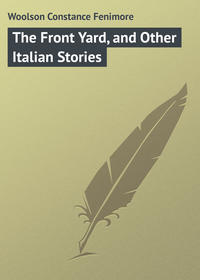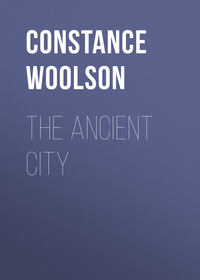 полная версия
полная версияMentone, Cairo, and Corfu
There are in Cairo black stories of cruelty connected with his name. These for the most part are unwritten; they are told in the native cafés and in the bazaars. It does not appear that he loved cruelty for its own sake, as some of the Roman emperors loved it; but if any one rebelled against his power or his pleasure, that person was sacrificed without scruple. In some cases it took the form of a disappearance in the night, without a sound or a trace left behind. This is the sort of thing we associate with the old despotic ages. But 1869 is not a remote date, and at that time the present Emperor of Austria, the late Emperor Frederick (then Crown-Prince of Prussia), the Empress Eugénie, Prince Oscar of Sweden, Prince Louis of Hesse, the Princess of the Netherlands, the Duke and Duchess of Aosta, and other distinguished Europeans, were the guests of this enigmatic host, eating his sumptuous dinners and attending his magnificent balls. The festivities in connection with the opening of the canal are said to have cost Ismail twenty-one millions of dollars. The sum seems large; but it included the furnishing of palaces, lavish hospitality to an army of guests besides the sovereigns and their suites, and an opera to order – namely, Verdi's Aïda, which was given with great brilliancy in Cairo, in an opera-house erected for the occasion. Ismail, like Mehemet, had his splendid dream. He, too, wished to free Egypt from the power of Turkey; but, unlike his grandfather, he wished to take her bodily into the circle of the civilized nations, not as a rival, but as an ally and friend. An Egyptian kingdom, under his rule, was to extend from the Mediterranean to the equator; from the Red Sea westward beyond Darfur. His bold ambition ended in disaster. His railways, telegraphs, schools, harbors, and postal-service, together with his personal extravagance, brought Egypt to the verge of bankruptcy. All Europe now had a vital interest in the Suez Canal, and the powers therefore united in a demand that the Sultan should stop the career of his audacious Egyptian Viceroy. The Viceroy might perhaps have resisted the Porte; he could not resist the united powers. In 1879 he was deposed, and his son Tufik appointed in his place. Ismail left Egypt. For several years he travelled, residing for a time in Naples; at present he is living in a villa near Constantinople. There is a rumor in Cairo that he is more of a prisoner there than he supposes. But this may be only one of the legends that are always attached to Turkish affairs. His dream has come true in one respect at least: Egypt has indeed joined the circle of the European nations, but not in the manner which Ismail intended; she is only a bondwoman – if the pun can be permitted.
THE HAUNTED PALACEThe Gezireh road is to-day the favorite afternoon drive of the Cairenes. It is a broad avenue, raised above the plain, and overarched by trees throughout its course. At many points it commands an uninterrupted view of the pyramids. Two miles from town the Gezireh Palace rises on the right, surrounded by gardens, which, unlike those of Choubra, are carefully tended. It was built by Ismail. Of all these Cairo palaces it must be explained that they have none of the characteristics of castles or strongholds; they are merely lightly built residences, designed for a climate which has ten months of summer. The central hall and grand staircase of Gezireh are superb; alabaster, onyx, and malachite adorn like jewels the beautiful marbles, which came from Carrara. The drawing-rooms and audience-chambers have a splendid spaciousness: the state apartments of many a royal palace in Europe sink into insignificance in this respect when compared with them. Much of the furniture is rich, but again (as in the old house of the Sheykh es Sadat) one finds it difficult to forgive the tawdry French carpets and curtains, when the bazaars close at hand could have contributed fabrics of so much greater beauty. But Ismail's taste was French – that is, the lowest shade of French – as French is still the taste of modern Egypt among the upper classes. It remains to be seen whether the English occupation will change this. During the festivities at the time of the opening of the canal, Ismail's royal guests were entertained at Gezireh. On the upper floor are the rooms which were occupied by the Empress Eugénie, the walls and ceilings covered with thick satin, tufted like the back of an arm-chair, its tint the shade of blue which is most becoming to a blond complexion – Ismail's compliment to his beautiful guest. During these days there were state dinners and balls at Gezireh, with banks of orchids, myriads of wax-lights, and orchestras playing strains from La Belle Hélène and La Grande Duchesse. During one of these balls the Emperor of Austria made a progress through the rooms with Ismail, band after band taking up the Austrian national anthem as the imperial guest entered. The vision of the stately, grave Franz Josef advancing through these glittering halls by the side of the waddling little hippopotamus of the Nile, to the martial notes of that fine hymn (which we have appropriated for our churches under another name, and without saying "By your leave"), is one of the sinister apparitions with which this rococo palace, a palace half splendid, half shabby, is haunted.
In the garden there is a kiosk whose proportions charm the eye. The guide-books inform us that this ornamentation is of cast-iron; that it is an imitation of the Alhambra; that it is "considered the finest modern Arabian building in the world" – all of which is against it. Nevertheless, viewed from any point across the gardens, its outlines are exquisite. Within there are more festal chambers, and a gilded dining-room, which was the scene of the suppers (they were often orgies) that were given by Ismail upon the occasion of his private masked balls. At some distance from the palace, behind a screen of trees, are the apartments reserved for the hareem. This smaller palace has no beauty, unless one includes its enchanting little garden; such attraction as it has comes from the light it sheds upon the daily life of Eastern women. Occidental travellers are always curious about the hareem. The word means simply the ladies, or women, of the family, and the term is made to include also the rooms which they occupy, as our word "school" might mean the building or the pupils within it. At Gezireh the hareem, save that its appointments are more costly, is much like those caravansaries which abound at our inland summer resorts. There are long rows of small chambers opening from each side of narrow halls, with a few sitting-rooms, which were held in common. The carpets, curtains, and such articles of furniture as still remain are all flowery, glaring, and in the worst possible modern taste, save that they do not exhibit those horrible hues, surely the most hideous with which this world has been cursed – the so-called solferinos and magentas. Besides their private garden, the women and children of the hareem had for their entertainment a small menagerie, an aviery, and a confectionery establishment, where fresh bonbons were made for them every day, especially the sugared rose leaves so dear to the Oriental heart. The chief of Ismail's four wives had a passion for jewels. She possessed rubies and diamonds of unusual size, and so many precious stones of all kinds that her satin dresses were embroidered with them. She had her private band of female musicians, who played for her, when she wished for music, upon the violin, the flute, the zither, and the mandolin. The princesses of the royal house, Ismail's wives and his sisters-in-law, could not bring themselves to admire the Empress of the French. They were lost in wonder over what they called her "pinched stiffness." It is true that the uncorseted forms of Oriental beauties have nothing in common with the rigid back and martial elbows of modern attire. Dimples, polished limbs, dark, long-lashed eyes, and an indolent step are the ideals of the hareem.
The legends of these jewelled sultanas, of the masked balls, of the long train of royal visitors, of the orchids, the orchestras, and the wax-lights, are followed at Gezireh by a tale of murder which is singularly ghastly. Ismail's Minister of Finance was his foster-brother Sadyk, with whom he had lived upon terms of closest intimacy all his life. The two were often together; frequently they drove out to Gezireh to spend the night. One afternoon in 1878 Ismail's carriage stopped at the doorway of the palace in Cairo occupied by his minister. Sadyk came out. "Get in," Ismail was heard to say. "We will go to Gezireh. There are business matters about which I must talk with you." The two men went away together. Sadyk never came back. When the carriage reached Gezireh, Ismail gave orders that it should stop at the palace, instead of going on to the kiosk, where they generally alighted. He himself led the way within, crossing the reception-room to the small private salon which overlooks the Nile. Here he seated himself upon a sofa, drawing up his feet in the Oriental fashion, which was not his usual custom. Sadyk was about to follow his example, when he found himself seized suddenly from behind. The doors were now locked from the outside, leaving within only the two foster-brothers and the man who had seized Sadyk. This was a Nubian named Ishak, a creature celebrated for his strength. He now proceeded to murder Sadyk after a fashion of his own country, a process of breaking the bones of the chest and neck in a manner which leaves on the skin no sign. Sadyk fought for his life; he dragged the Nubian over the white velvet carpet, and finally bit off two of his fingers. But he was not a young man, and in the end he was conquered. During this struggle Ismail remained motionless on the sofa, with his feet drawn up and his arms folded. A steamer lay at anchor outside, and during the night Sadyk's body was placed on board; at dawn the boat started up the river. At the same hour Ismail drove back to Cairo, where, in the course of the morning, it was officially announced that the Minister of Finance, having been detected in colossal peculations, had been banished to the White Nile, and was already on his way thither. Sadyk's body rests somewhere at the bottom of the river. But Ismail's little drama of banishment and the steamer were set at naught when, after he had left Cairo, Ishak the Nubian returned, with his mutilated hand and his story. Such is the tale as it is told in the bazaars. Ismail's motive in murdering a man he liked (he was incapable of true affection for any one) is found in the fact that he could place upon the shoulders of the missing minister the worst of the financial irregularities which were trying the patience of the European powers. It did him no good. He was deposed the next year.
During the spring of 1890 Gezireh awoke to new life for a time. A French company had purchased the place, with the intention of opening it as an Egyptian Monte Carlo. But Khedive Tufik, who has prohibited gambling throughout his domain, forbade the execution of this plan. So the tarnished silks remain where they were, and the faded gilded ceilings have not been renewed. When we made our last visit, during the heats of early summer, the blossoms were as beautiful as ever, and the ghosts were all there – we met them on the marble stairs: the European princes, led by poor Eugénie; the sultanas, with their jewels and their band; Ismail, with his drooping eyelids; and Sadyk, followed by the Nubian.
TUFIKThe present Khedive (or Viceroy) is thirty-eight years of age. Well proportioned, with fine dark eyes, he may be called a handsome man; but his face is made heavy by its expression of settled melancholy. It is said in Cairo that he has never been known to laugh. But this must apply to his public life only, for he is much attached to his family – to his wife and his four children; in this respect he lives strictly in the European manner, never having had but this one wife. He is a devoted father. Determined that the education of his sons should not be neglected as his own education was neglected by Ismail, he had for them, at an early age, an accomplished English tutor. Later he sent them to Geneva, Switzerland; they are now in Vienna. Tufik's chief interest, if one may judge by his acts, is in education. In this direction his strongest efforts have been made; he has improved the public schools of Egypt, and established new ones; he has given all the support possible to that greatest of modern innovations in a Mohammedan country, the education of women. With all this, he is a devout Mohammedan; he is not a fanatic; but he may be called, I think, a Mohammedan Puritan. He receives his many European and American visitors with courtesy. But they do not talk about him as they talked about Ismail; he excites no curiosity. This is partly owing to his position, his opinions and actions having naturally small importance while an English army is taking charge of his realm; but it is also owing, in a measure, to the character of the man himself. One often sees him driving. On Sunday afternoons his carriage in semi-state leads the procession along the Gezireh Avenue. First appear the outriders, six mounted soldiers; four brilliantly dressed saises follow, rushing along with their wands high in the air; then comes the open carriage, with the dark-eyed, melancholy Khedive on the back seat, returning mechanically the many salutations offered by strangers and by his own people. Behind his carriage are four more of the flying runners; then the remainder of the mounted escort, two and two. At a little distance follows the brougham of the Vice-reine; according to Oriental etiquette, she never appears in public beside her husband. Her brougham is preceded and followed by saises, but there is no mounted escort. The Vice-reine is pretty, intelligent, and accomplished; in addition, she is brave. Several years ago, when the cholera was raging in Cairo, and the Khedive, almost alone among the upper classes, remained there in order to do what he could for the suffering people, his wife also refused to flee. She stayed in the plague-stricken town until the pestilence had disappeared, exerting her influence to persuade the frightened women of the lower classes to follow her example regarding sanitary precautions. Tufik is accused of being always undecided; he was not undecided upon this occasion at least. It is probable that some of his moments of indecision have been caused by real hesitations. And this brings us to Arabi.
Arabi (he is probably indifferent to the musical sound of his name) was the leader of the military revolt which broke out in Egypt in 1881 – a revolt with which all the world is familiar, because it was followed by the bombardment of Alexandria by the English fleet. Arabi had studied at El Azhar; he knew the Koran by heart. To the native population he seemed a wonderful orator; he excited their enthusiasm; he roused their courage; he almost made them patriotic. The story of Arabi is interesting; there were many intrigues mixed with the revolt, and a dramatic element throughout. But these slight impressions – the idle notes merely of one winter – are not the place for serious history. Nor is the page completed so that it can be described as a whole. Egypt at this moment is the scene of history in the actual process of making, if the term may be so used – making day by day and hour by hour. Arabi has been called the modern Masaniello. The watchword of his revolt was, "Egypt for the Egyptians"; and there is always something touching in this cry when the invaded country is weak and the incoming power is strong. But it may be answered that the Egyptians at present are incapable of governing themselves; that the country, if left to its own devices, would revert to anarchy in a month, and to famine, desolation, and barbarism in five years. Americans are not concerned with these questions of the Eastern world. But if a similar cry had been successfully raised about two hundred years ago on another coast – "America for the Americans" – would the Western continent have profited thereby? Doubtless the original Americans – those of the red skins – raised it as loudly as they could. But there was not much listening. The comparison is stretched, for the poor Egyptian fellah is at least not a savage; but there is a grain of resemblance large enough to call for reflection, when the question of occupation and improvement of a half-civilized land elsewhere is under discussion. The English put down the revolt, and sent Arabi to Ceylon, a small Napoleon at St. Helena. The rebel colonel and his fellow-exiles are at present enjoying those spicy breezes which are associated in our minds with foreign missions and a whole congregation singing (and dragging them fearfully) the celebrated verses. Arabi has complained of the climate in spite of the perfumes, and it is said that he is to be transferred to some other point in the ocean; there are, indeed, many of them well adapted for the purpose. The English newspapers of to-day are dotted with the word "shadowed," which signifies, apparently, that certain persons in Ireland are followed so closely by a policeman that the official might be the shadow. Possibly the melancholy Khedive is shadowed by the memory of the exile of Ceylon. For Tufik did not cast his lot with Arabi. He turned towards the English. To use the word again, though with another signification, though ruler still, he has but a shadowy power.
THE ARAB MUSEUMNear the city gate named the Help of God, on the northeastern border of Cairo, is the old mosque El Hakim. Save its outer walls, which enclose, like the mosques of Touloun and Amer, a large open square, there is not much left of it; but within this square, housed in a temporary building, one finds the collection of Saracenic antiquities which is called the Arab Museum.
This museum is interesting, and it ought to be beautiful. But somehow it is not. The barrack-like walls, sparsely ornamented with relics from the mosques, the straight aisles and glass show-cases, are not inspiring; the fragments of Arabian wood-carving seem to be lamenting their fate; and the only room which is not desolate is the one where old tiles lie in disorder upon the floor, much as they lie on broken marble pavements of the ancient houses which, half ruined and buried in rubbish, still exist in the old quarters. Why one should be so inconsistent as to find no fault with Gizeh, where rows of antiquities torn from their proper places confront us, where show-cases abound, and yet at the same time make an outcry over this poor little morsel at El Hakim, remains a mystery. Possibly it is because the massive statues and the solid little gods of ancient Egypt do not require an appropriate background, as do the delicate fancies of Saracenic taste. However this may be, to some of us the Arab Museum looks as if a New England farmer's wife had tried her best to make things orderly within its borders, poor soul, in spite of the strangeness of the articles with which she was obliged to deal. It must, however, be added that the museum will not make this impression upon persons who are indifferent to the general aspect of an aisle, or of a series of walls – persons who care only for the articles which adorn them – the lovers of detail, in short. And it is well for all of us to join this class as soon as our feet have crossed the threshold. For we shall be repaid for it. The details are exquisite.
The Arab Museum has been established recently. Every one is grateful to the zeal which has rescued from further injury so many specimens of a vanishing art. One covets a little chest for the Koran which is made of sandal-wood. It is incrusted with arabesques carved in ivory, and has broad hasps and locks of embossed silver. There are many koursis, or small, stool-like tables; one of these has panels of silver filigree, and fretted medallions bearing the name of the Sultan Mohammed ebn Kalaoon, thus showing that it once belonged to the mosque at the Citadel which was built by that Memlook ruler – the mosque whose minarets are ornamented with picturesque bands of emerald-hued porcelain. The illuminated Korans are not here; they are kept in the Public Library in the Street of the Sycamores. Perhaps the most beautiful of the museum's treasures are the old lamps of Arabian glass. In shape they are vases, as they were simply filled with perfumed oil which carried a floating wick; the colors are usually a pearly background, faintly tinged sometimes by the hue we call ashes of roses; upon this background are ornaments of blue, gold, and red; occasionally these ornaments are Arabic letters forming a name or text. These lamps were made in the thirteenth and fourteenth centuries; the glass, which has as marked characteristics of its own as Palissy ware, so that once seen it can never be confounded with any other, has a delicate beauty which is unrivalled.
HELIOPOLISLike the pyramids, Heliopolis belongs to Cairo. On the way thither, one first traverses the pleasant suburb of Abbasieh. How one traverses it depends upon his taste. The most enthusiastic pedestrian soon gives up walking in the city of the Khedive save in the broad streets of the new quarter. The English ride, one meets every day their gallant mounted bands; but these are generally residents and their visitors, and the horses are their own; for the traveller there are only the street carriages and the donkeys. The carriages are dubiously loose-jointed, and the horses (whose misery has already been described) have but two gaits – the walk of a dying creature and the gallop of despair; unless, therefore, one wishes to mount a dromedary, he must take a donkey. But the "must" is not a disparagement; the white and gray donkeys of Cairo – the best of them – are good-natured, gay-hearted, strong, and even handsome. They have a coquettish way of arching their necks and holding their chins (if a donkey can be said to have a chin), which always reminded me of George Eliot's description of Gwendolen's manner of poising her head in Daniel Deronda. George Eliot goes on to warn other young ladies that it is useless to try to imitate this proud little air, unless one has a throat like Gwendolen's. And, in the same spirit, one must warn other donkeys that they must be born in Cairo to be beautiful. Upon several occasions I recognized vanity in my donkey. He knew perfectly when he was adorned with his holiday necklaces – one of imitation sequins, the other of turquoise-hued beads. I am sure that he would have felt much depressed if deprived of his charm against magic – the morsel of parchment inscribed with Arabic characters which decorated his breast. His tail and his short mane were dyed fashionably with henna, but his legs had not been shaved in the pattern which represents filigree garters, and whenever a comrade who had this additional glory passed him, he became distinctly melancholy, and brooded about it for several minutes. There is nothing in the world so deprecating as the profile of one of these Cairo donkeys when he finds himself obliged, by the pressure of the crowd, to push against a European; his long nose and his polite eye as he passes are full of friendly apologies. The donkey-boy, in his skull-cap and single garment, runs behind his beast. These lads are very quick-witted. They have ready for their donkeys five or six names, and they seldom make a mistake in applying them according to the supposed nationality of their patrons of the moment, so that the Englishman learns that he has Annie Laurie; the Frenchman, Napoleon; the German, Bismarck; the Italian, Garibaldi; and the Americans, indiscriminately, Hail Columbia, Yankee Doodle, and General Grant.
In passing through the Abbasieh quarter, we always came, sooner or later, upon a wedding. The different stages of a native marriage require, indeed, so many days for their accomplishment that nuptial festivities are a permanent institution in Cairo, like the policemen and the water-carts, rather than an occasional event, as in other places. One day, upon turning into a narrow street, we discovered that a long portion of it had been roofed over with red cloth; from the centre of this awning four large chandeliers were suspended by cords, and at each end of the improvised tent were hoops adorned with the little red Egyptian banners which look like fringed napkins. In the roadway, placed against the walls of the houses on each side, were rows of wooden settees; one of these seats was occupied by the band, which kept up a constant piping and droning, and upon the others were squatted the invited guests. Every now and then a man came from a gayly adorned door on the left, which was that of the bridegroom, bringing with him a tray covered with the tiny cups of coffee set in their filigree stands; he offered coffee to all. In the meanwhile, in the centre of the roadway between the settees, an Egyptian, in his long blue gown, was dancing. The expression of responsibility on his face amounted to anxiety as he took his steps with great care, now lifting one bare foot as high as he could, and turning it sidewise, as if to show us the sole; now putting it down and hopping upon it, while he displayed to us in the same way the sole of the other. This formal dancing is done by the guests when no public performers are employed. Some one must dance to express the revelry of the occasion; those who are invited, therefore, undertake the duty one by one. When at last we went on our way we were obliged to ride directly through the reception, our donkeys brushing the band on one side and the guests on the other; the dancer on duty paused for a moment, wiping his face with the tail of his gown.









